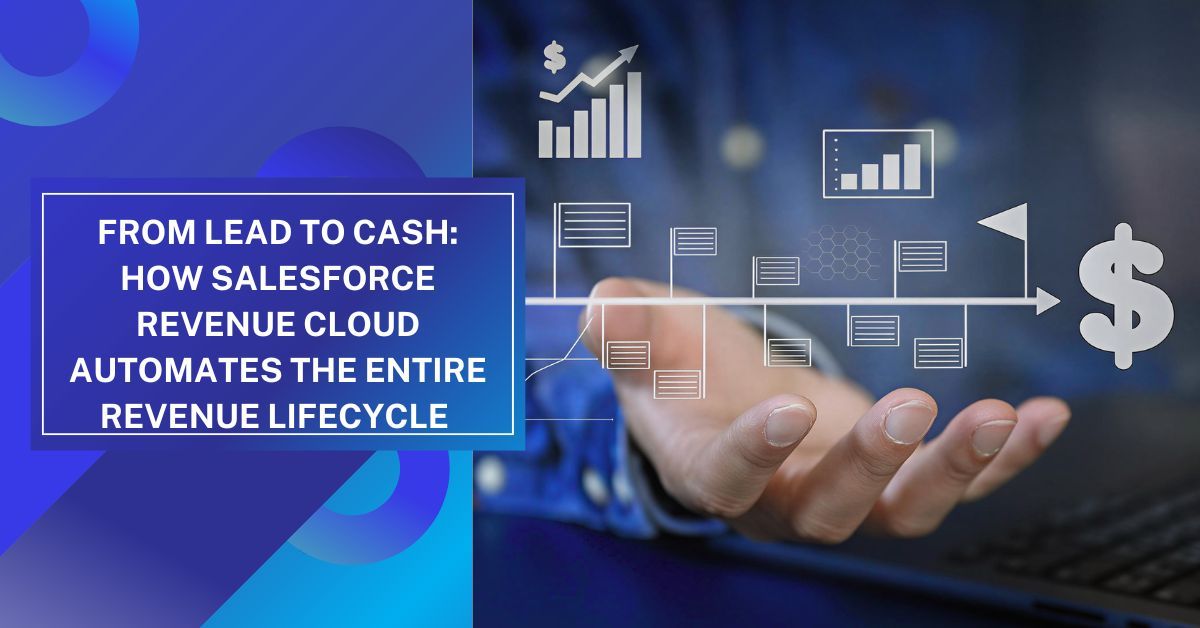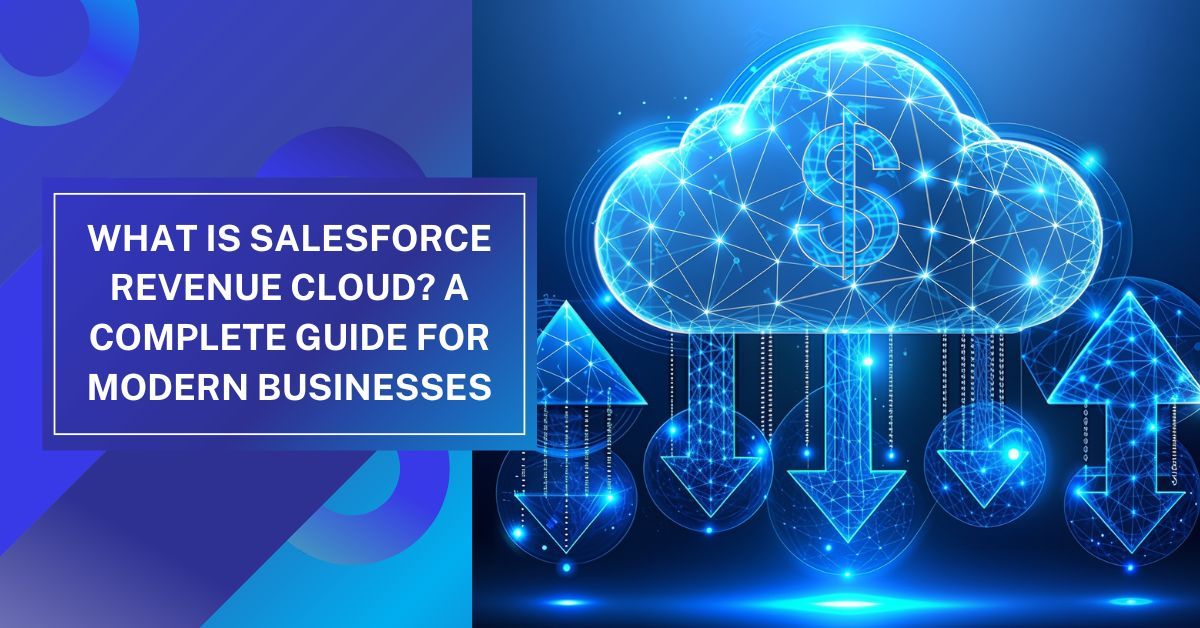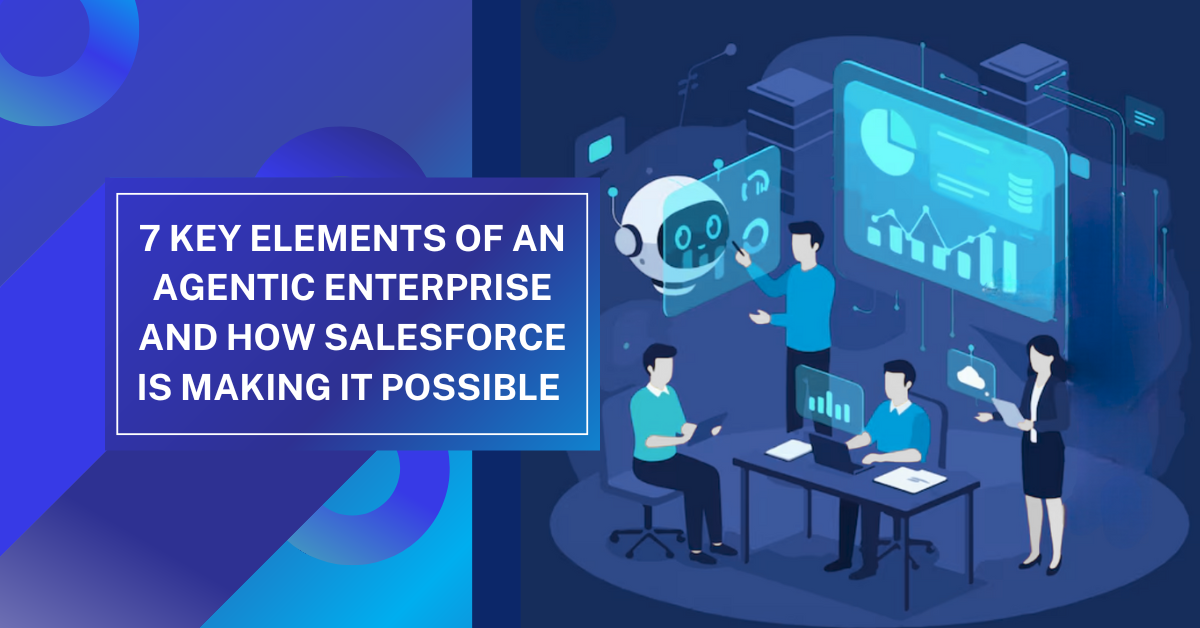In today’s evolving digital economy, managing revenue efficiently isn’tjust about closingdeals,it’s about creating a connected ecosystem where sales, finance, and partners work in harmony. Salesforce Revenue Cloud makes this possible through four powerful components,CPQ, Billing, CPQ for Partner Communities, and CPQ for Customer Communities.
Each of these plays a unique role in transforming your revenue process into a seamless, automated journey from quoting to cash to renewal.
Let’s break down the core components that power Salesforce Revenue Cloud:

1. Configure, Price, Quote (CPQ): Simplifying Complex Sales
- Sales teams often face the challenge of balancing speed with accuracy. Complex product catalogs, customized pricing, and multi-level approvals can easily slow down deal cycles.
- That’s where Salesforce CPQ comes in.It helps sales reps configure the right products, apply accurate pricing, and generate quotes within minutes all from one unified platform.
Key Advantages:
- Guided Selling: Helps reps choose the right combinations and upsells without confusion.
- Automated Pricing Rules:Maintains consistent discounts and bundles across deals.
- Error-Free Quotes:Eliminates manual mistakes and ensures approvals are streamlined.
- With CPQ, businesses can move from spreadsheet-based quoting to intelligent automation boosting productivity, shortening sales cycles, and improving customer confidence in every proposal.
2. Billing: Connecting Sales and Finance Seamlessly
- Once a quote is approved, finance teams often struggle with manual billing processes that delay payments and cause reporting inconsistencies.
- Salesforce Billing solves this by extending the CPQ data directly into the invoicing and payment stages.
Key Advantages:
- Automated Invoicing: Instantly generates accurate invoices based on approved quotes.
- Flexible Payment Models: Supports one-time, recurring, or usage-based billing.
- Revenue Recognition Compliance: Automatically aligns with accounting standards like ASC 606 or IFRS 15.
- Real-Time Financial Visibility: Tracks outstanding payments, renewals, and cash flow in one view.
- Salesforce Billing bridges the gap between sales and finance, ensuring both teams operate on a single source of truth. The result? Faster cash flow, fewer errors, and better financial forecasting.
3. CPQ for Partner Communities: Empowering Your Channel Partners
- For many businesses, indirect sales through distributors, resellers, or agents contribute significantly to total revenue.
- However, managing partner quotes and approvals manually can lead to inconsistencies, pricing errors, and slower deal turnaround.
- CPQ for Partner Communities enables your partners to create, modify, and submit quotes directly through your Salesforce Partner Community portal with the same accuracy and control as your internal sales team.
Key Advantages:
- Self-Service Quoting: Partners can independently configure products, apply pricing, and generate quotes.
- Centralized Pricing Rules: Ensures partners always use up-to-date discounts and offers.
- Faster Deal Collaboration: Streamlines the approval process between internal and external teams.
- By empowering partners with CPQ, businesses can scale their sales operations globally without compromising accuracy or control.
- Every quote that enters your system follows the same rules and standards as internal sales, creating a consistent customer experience across all channels.
4. CPQ for Customer Communities: Enabling Self-Service Selling
- Modern buyers expect speed, transparency, and autonomy. CPQ for Customer Communities empowers your customers to explore products, configure their own solutions, and request quotes directly all through a self-service portal connected to Salesforce.
Key Advantages:
- Customer Empowerment: Allows customers to view products, select configurations, and request quotes instantly.
- Faster Sales Cycles: Reduces dependency on sales reps for routine configurations or renewals.
- Personalized Experiences: Displays dynamic pricing and offers based on customer profiles or previous purchases.
- Real-Time Integration: Every customer quote automatically syncs with Salesforce, maintaining accuracy across systems.
- By giving customers the ability to manage their own quoting process, you not only improve convenience but also free your sales team to focus on strategic, high-value opportunities.
How These Components Work Together?
- The four components — CPQ, Billing, CPQ for Partner Communities, and CPQ for Customer Communities — are not isolated tools but part of a unified ecosystem within Salesforce Revenue Cloud.
- Each component plays a vital role in optimizing a different stage of the revenue process while seamlessly connecting with others to ensure a consistent flow of data and collaboration across departments.
- Together, they eliminate silos between sales, finance, and partner channels, automate complex processes, and enhance visibility throughout the quote-to-cash journey.
- This integrated approach enables businesses to operate more efficiently, reduce manual errors, and deliver a smooth, customer-centric revenue experience from start to finish.
Here’s how the connected flow works across Salesforce Revenue Cloud.
- It starts with Salesforce CPQ, which helps sales teams create accurate, rule-based quotes aligned with company pricing and product configurations.
- Once approved, Salesforce Billing automates invoicing, payment collection, and revenue recognition ensuring compliance and accuracy.
- CPQ for Partner Communities empowers external partners to generate quotes and close deals seamlessly, while CPQ for Customer Communities gives customers self-service access to configure products, request quotes, and manage renewals.
Together, these components create a unified revenue ecosystem that boosts efficiency, reduces manual work, and delivers a consistent experience for teams, partners, and customers alike.
How Revenue Cloud Creates a Connected Business Ecosystem

- In most organizations, sales, finance, and operations often operate in silos using different tools, data sources, and workflows. This fragmentation leads to delays, miscommunication, and revenue leakage.
- Salesforce Revenue Cloud bridges these gaps by connecting every team and process involved in the revenue cycle.
- From product configuration and pricing to billing and renewals, every activity happens within one unified platform.
- With shared data and real-time visibility, departments can collaborate seamlessly. Sales teams can instantly track order statuses, finance can automate invoicing and revenue recognition, and leadership gains accurate forecasting and performance insights.
- This connected ecosystem doesn’t just simplify operations it drives efficiency, accuracy, and growth.
- Businesses can focus on innovation and customer success rather than managing fragmented tools or reconciling data manually.
Key Business Challenges Salesforce Revenue Cloud Solves
- Managing revenue across multiple teams and systems can quickly become chaotic. Salesforce Revenue Cloud solves these challenges by unifying sales, finance, and operations into one connected platform.
Here’s how Salesforce Revenue Cloud makes an impact:
- Eliminates Silos: Connects departments to ensure consistent data and faster collaboration.
- Reduces Pricing Errors: Automates quoting and approvals with CPQ for accurate, compliant pricing.
- Simplifies Billing: Handles complex billing models — from subscriptions to usage-based — effortlessly.
- Accelerates Partner Sales: Empowers partners with CPQ access to generate quotes and close deals faster.
- Improves Customer Visibility: Delivers a complete view of each customer to boost renewals and upsells.
By removing friction from the quote-to-cash cycle, Revenue Cloud empowers businesses to sell faster, smarter, and more efficiently.
What’s Next in the Series
- Now that we’ve explored the core components of Salesforce Revenue Cloud — CPQ, Billing, and Subscription Management — it’s time to see them in action.
- In our next blog, “From Lead to Cash: How Salesforce Revenue Cloud Automates the Entire Revenue Lifecycle,”we’ll walk through the complete Quote-to-Cash journey and show how Salesforce connects every step — from quoting to revenue recognition — into one seamless process.
- Stay tuned for real-world insights and practical examples on transforming your revenue operations with Salesforce.
Conclusion
Salesforce Revenue Cloud redefines how businesses sell, bill, and grow — combining automation with real-time insights.By leveraging CPQ, Billing, Partner Communities, and Customer Communities, organizations can ensure every quote, invoice, and renewal works in harmony, no matter the industry or business model.
Whether you’re a SaaS company managing subscriptions or a manufacturer handling complex pricing, Salesforce Revenue Cloud offers the agility and transparency you need to drive consistent growth and deliver exceptional customer experiences.
 Neel Thakkar
Neel Thakkar 



